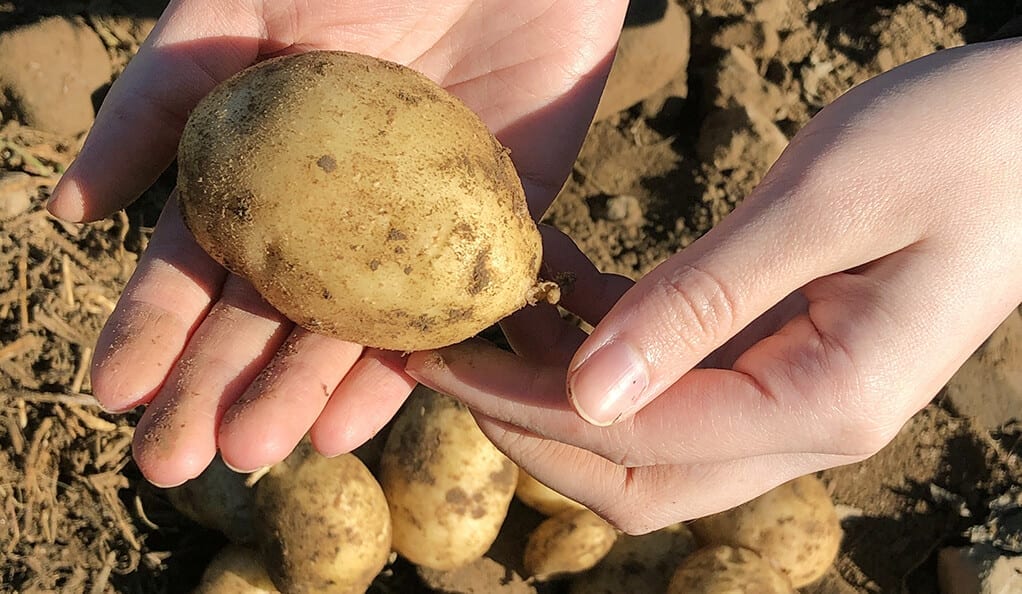You cannot use what’s happening above ground as a guide to what’s happening below, according to new research into alternative desiccants.
A key finding from the work is that the rate of foliage desiccation does not correlate well with that of skinset, the key to harvesting without damage. The discovery was among the key findings of a project examining the best alternative desiccants to diquat, carried out by NIAB CUF on behalf of AHDB. The research focused on the ‘hard to stop’ situations such as indeterminate varieties and seed crops.
The final report also made practical recommendations on using the protoporphyrinogen oxidase (PPO) inhibitors, Gozai and Spotlight Plus, and examined the performance of Saltex, which currently doesn’t have approval from the Chemicals Regulations Directorate (CRD).
Practical advice for growers summary from project
- When using PPO inhibitors, aim for early to mid-morning application
- Aim to stop irrigation 7 days prior to desiccation
- Harvesting schedule needs to take account of 2-4 day skinset delay (compared with diquat) when using Gozai and Spotlight Plus
- Kill all the leaves and take measures to prevent re-growth to control blight and viral infection in seed crops.
Leaf defoliation
Reglone (diquat) was the most effective chemical defoliant, though at some sites the brine solution Saltex was equally fast in reducing ground cover. Saltex was more dependent on atmospheric conditions immediately following spraying than Reglone. It is most effective in hot sunshine.
In trials looking at Spotlight and Gozai, no difference was found in the rate of canopy death. However both were 2 to 4 days slower than Reglone and 7 days slower than Reglone in a trial looking at Scottish seed crop.
The slowest treatment was Finalsan, which left up to 67 % green ground cover 14 days after the initial spray application. The other chemical desiccants had killed most of the leaf area by this point.
Skinset
There were no significant differences observed in skinset three weeks after initial treatment within individual experiments looking at Spotlight and Gozai, Reglone, Saltext, flail or haulm pulling.
When the data was averaged over all experiments the researchers found a small advantage in reaching skinset using Reglone, mechanical and Saltex methods compared to treatments with PPO inhibitors and Finalsan, however the difference was small at 2-4 days.
The researchers noted that skinset did always correlate with leaf death. In one experiment, all the trial plots had the same level of (poor) skinset 2 weeks after initial treatment, including the undefoliated crops making up the control group. A week later, all the defoliated treatments – excluding the control – were at or within 1 day of skinset.
Head of NIAB CUF Dr Mark Stalham, who led the research, said: “What this shows is that skinset depends on a number of factors, not just canopy death.”
“We found that in the case of one variety, despite the fairly rapid loss of leaf cover, it was desiccation of the stems that delayed skinset.”
“What this shows is that skinset depends on a number of factors, not just canopy death. We found that in the case of one variety, despite the fairly rapid loss of leaf cover, it was desiccation of the stems that delayed skinset.” Dr Mark Stalham, NIAB CUF
he research found that defoliation method, chemical or timing had little effect on vascular browning, stem-end necrosis, stolon adhesion or on rotting or skin blemishing diseases, either pre or post-storage. Similarly, there were no effects from either chemical or mechanical haulm destruction on rotting or surface blemishing diseases, either at harvest or after storage.
Practical guidance
In terms of practical guidance, the report recommends applying PPO inhibitors early to mid-morning to give the chemical the maximum time to kill cells. The timing of Spotlight and Gozai can be more crucial later in the season when it is cooler.
Other recommendations include stopping irrigation 7 days prior to desiccation as skins set faster in drier soils. The timing of the last irrigation prior to desiccation (particularly in salad crops), would influence skinset. Harvest schedules also need to take account of the 2-4 day delay in skinset when using PPOs compared to diquat.
As well as chemical desiccants, assessments were made of mechanical options: both ‘flailing’, using tractor-mounted flails, and a hand simulated haulm puller, applied to the seed crop experiments. Both methods resulted in instant canopy removal, with some variation in stem length left.
The mechanical methods also prevented ‘passive bulking’, whereby the tuber continues to grow despite initial treatment with a desiccant. The trials provided no evidence of large differences in passive bulking between chemical treatments.
Desiccation depends on more than desiccants
It is important to remember that 2019 offered conditions that were favourable to desiccation due to early planting and good conditions in the spring, meaning the crop was able to get off to a good start. Skinset could well be slower in a successive year, with greater differences between treatments.
Previous AHDB sponsored work by NIAB CUF has suggested that reducing the nitrogen rate can make desiccation easier. Dr Stalham will run further tests this year to develop a quick, quantitative, method to assess skinset in the field.
AHDB will host webinars later this year looking at in-field haulm destruction applications on 19 August, followed by another on in-field haulm destruction effects on 16 September.
